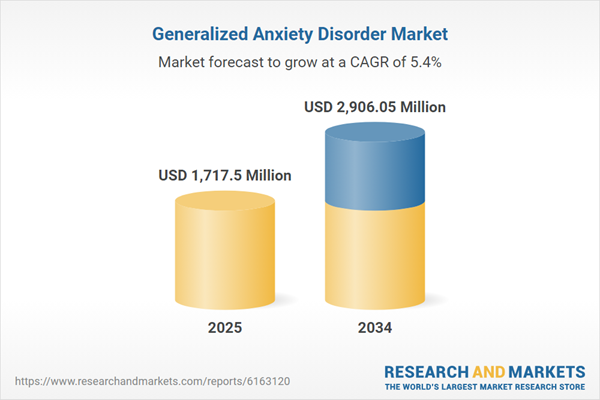Generalized Anxiety Disorder: Introduction
Generalized anxiety disorder (GAD) is marked by persistent feelings of tension and worry that do not seem to go away. Common symptoms include trembling, twitching, trouble falling or staying asleep, sweating, tense muscles, nausea, and trouble breathing, among others. Medicines, counselling, lifestyle changes, and relaxation techniques are some of the common methods used to treat GAD. It may also worsen or instigate other physical conditions, such as insomnia, irritable bowel syndrome, headaches, and migraines.Generalized Anxiety Disorder Market Analysis
The generalized anxiety disorder market demand is driven by the modern fast paced lifestyles that induce high stress levels in the people. With rising incidence of the condition, there has been heightened awareness and education about addressing mental health issues with proper care. Rapid advancements have been made in diagnostic and screening methods to offer proper treatment to patients.Conventionally, pharmacological treatment alternatives like duloxetine, escitalopram, pregabalin, quetiapine, and venlafaxine have been used in the market. However, with rising technological advancements in drug development, researchers have developed a non-sedating drug treatment for GAD. BNC210 is a newly developed drug that reduces anxiety by working on cholinergic, a different chemical system in the brain essential in forming memories and signalling uncertainty.
In April 2023, Sunovion Pharmaceuticals Inc. and Otsuka Pharmaceutical Development & Commercialization, Inc. collaborated to initiate a phase II and III clinical study for Ulotaront, a potential treatment for generalized anxiety disorder (GAD). The rising drug developments using a diverse set of approaches to cater to a wider audience are also expected to impact the generalized anxiety disorder market value positively in the forecast period.
Apart from pharmaceuticals, psychological interventions like cognitive behavioural therapy are commonly used to manage GAD.
Generalized Anxiety Disorder Market Segmentation
“Generalized Anxiety Disorder Market Report and Forecast 2025-2034” offers a detailed analysis of the market based on the following segments:Market Breakup by Therapeutic Type
- Antidepressant
- Buspirone
- Benzodiazepines
Market Breakup by Therapy Type
- Interpersonal Therapy
- Behavior Therapy
- Cognitive Behavioral Therapy
- Mindfulness Based Cognitive Therapy
Market Breakup by Diagnosis
- Deep Brain Stimulation
- Electroconvulsive Therapy
- Transcranial Magnetic
- Stimulation Vagus Nerve
Market Breakup by Region
- United States
- United Kingdom
- Germany
- France
- Italy
- Spain
- Japan
Generalized Anxiety Disorder Market Overview
North America holds a significant generalized anxiety disorder market share. Since the population has high awareness of mental health issues, they are more familiar and comfortable with the treatment and management of the disease. The presence of influential pharmaceutical companies keeps working on new drug formulations for patient welfare.With a well-equipped medical infrastructure, Europe is another major market for GAD. With higher research and academic institutions, the number of product launches and clinical trials occurring in the region is higher. Regulatory frameworks, like the European Medicine Agency, also play a pivotal role in maintaining the efficacy of drug therapies.
The Asia Pacific region is witnessing expediated generalized anxiety disorder market growth due to declining stigmas associated with mental health issues. With increasing urbanisation and changing lifestyles, stress related issues have grown in the people residing in the region. With a vision to address such issues properly, several private and government institutions have partnered to impart education on the same.
Generalized Anxiety Disorder Market: Competitor Landscape
The key features of the market report include patent analysis, grants analysis, clinical trials analysis, funding and investment analysis, partnerships, and collaborations analysis by the leading key players. The major companies in the market are as follows:- Eli Lilly and Company
- GlaxoSmithKline Pharmaceuticals Limited
- Pfizer, Inc.
- Abbott Laboratories
- Bristol-Myers Squibb
- Actavis Pharmaceutical Company
- F. Hoffmann-La Roche
- Sumitomo Dainippon Pharma
- MindMed
- VistaGen Therapeutics, Inc
- Mitsubishi Chemical Group Corporation
- Sanofi
- Mitsubishi Chemical Group Corporation
- Forest Laboratories, Inc
- H. Lundbeck A/S
This product will be delivered within 3-5 business days.
Table of Contents
Companies Mentioned
- Eli Lilly and Company
- GlaxoSmithKline Pharmaceuticals Limited
- Pfizer, Inc.
- Abbott Laboratories
- Bristol-Myers Squibb
- Actavis Pharmaceutical Company
- F. Hoffmann-La Roche
- Sumitomo Dainippon Pharma
- MindMed
- VistaGen Therapeutics, Inc
- Mitsubishi Chemical Group Corporation
- Sanofi
- Mitsubishi Chemical Group Corporation
- Forest Laboratories, Inc
- H. Lundbeck A/S
Table Information
| Report Attribute | Details |
|---|---|
| No. of Pages | 350 |
| Published | July 2025 |
| Forecast Period | 2025 - 2034 |
| Estimated Market Value ( USD | $ 1717.5 Million |
| Forecasted Market Value ( USD | $ 2906.05 Million |
| Compound Annual Growth Rate | 5.4% |
| Regions Covered | Global |
| No. of Companies Mentioned | 15 |









